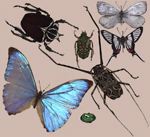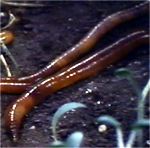
Candidate Transitional Forms Between Invertebrates and Vertebrates (Sidebar 3)

If evolution is true, then there must be some transition forms between the invertebrates and vertebrates. Three phyla have traditionally been considered candidates: Arthropoda, Annelida, and Echinodermata.

| Arthropoda | Annelida | Echinodermata | 
Click thumb-nail image
to see larger picture
(34K about 14 seconds
on a 28.8 modem) |  | 
Click thumb-nail image
to see larger picture
(24K about 10 seconds
on a 28.8 modem) |

The gap to be bridged is between organisms that do not have the four distinguishing characteristics (notochord, pharyngeal pouches, dorsal hollow central nervous system, and vertebrae) and those that do. Ostracoderms (a type of fossil fish) are considered to be the first vertebrate to appear in the fossil record (Ordovician/Paleozoic - Period/Era).



They had no jaws or paired fins and fed by filtering food from that freshwater environment. Their skin was covered with bony plates.
Below is a hypothetical evolutionary tree of how this process may have taken place. Keep in mind that this is a mental construct that attempts to show relationships that have not been proven. Evolving new organs and body plans is easy to talk about but practically impossible to demonstrate. Thus, a series of subphyla of the Phylum Chordata have been proposed as invertebrate intermediates. These are not on direct line to vertebrates, but indicative of how various innovations may have been added to the fundamental plan of say larval echinoderms to make permanent bilateral symmetrical animals with the four primary characteristics of all vertebrates. 
Definitions:
Bilateral symmetry:
 matching structures on both sides of an organism matching structures on both sides of an organism
Ciliated larvae:
 larval forms that have cilia on their surface for locomotion larval forms that have cilia on their surface for locomotion
Coelomate:
 having a body cavity having a body cavity
Dermal bone:
 bony deposits or plates that are located in the skin bony deposits or plates that are located in the skin
Deuterostome:
 an animal that uses the blastopore as an anus and forms a second mouth an animal that uses the blastopore as an anus and forms a second mouth
Dorsal and ventral nerve cords:
 nerve strings positioned either on the back or front of an animal nerve strings positioned either on the back or front of an animal
Dorsal hollow nerve cord:
 bundle of nerves that have a central fluid filled channel bundle of nerves that have a central fluid filled channel
Gill slits:
 openings between pharyngeal pouches openings between pharyngeal pouches
Mineralized mesoderm:
 bony deposits in the middle tissue of the body bony deposits in the middle tissue of the body
Notochord:
 a specialized tissue for support of the body a specialized tissue for support of the body
Sessile:
 attached to the substrate attached to the substrate
Radial symmetry:
 structures projecting out from a center hub structures projecting out from a center hub
 | 
